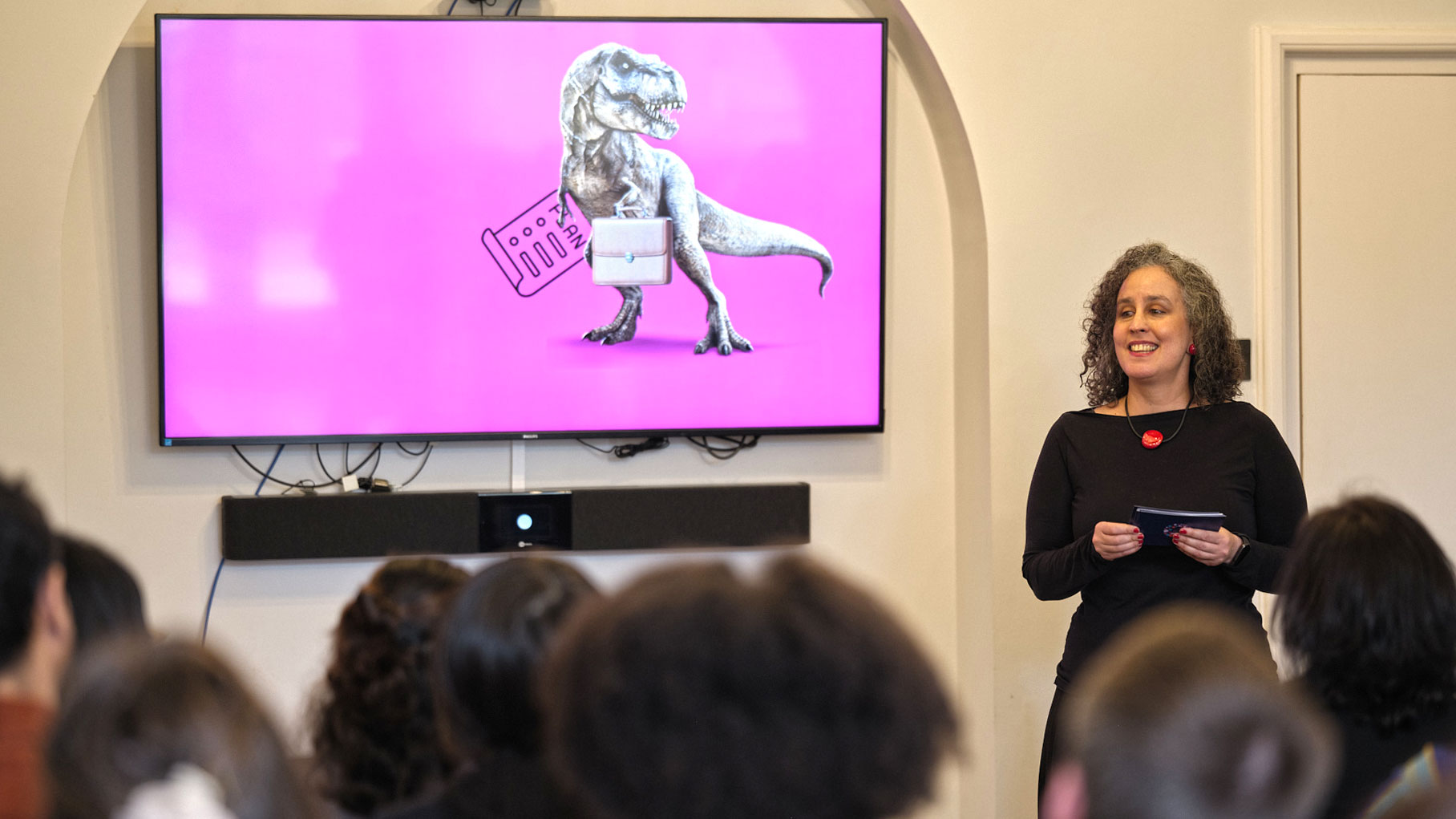The looming threat (and possible solutions) to Latin America’s foreign donor-funded journalism

Francisca Skoknic shares the findings of her project at the 2024 Spring Showcase. (Image: Andrew Bailey)
In a region plagued by poverty, inequality, and attacks on press freedom, Latin American journalists have ventured into non-profit journalism to uphold democracy.
Outlets producing award-winning and highly impactful journalism in the region include El Salvador’s El Faro, founded in 1998, Chile’s Ciper (2007), IDL-Reporteros in Peru and La Silla Vacía in Colombia (2009), Animal Político in Mexico (2010), Agência Pública in Brazil and Plaza Pública in Guatemala (2011) – to name a few.
But finding a sustainable financing model has eluded most outlets. There is limited advertising revenue for such controversial topics, and lower income audiences are hard-pressed to pay for news. This has led to an over-reliance on foreign funding to finance their work. Research by SembraMedia found that grants are the primary source of non-profit income, accounting for 63% of their revenue on average.
Gathering the data
To assess for myself how acutely reliant independent media in Latin America are on foreign donors, I set about analysing 40 independent outlets based in 16 countries. I focused on outlets that produce public interest journalism, play a significant role in their countries, and receive institutional foreign funding.
After reviewing funding information published by each of these outlets, it was possible to identify 70 different sources of income. These included: philanthropic foundations (OSF, Ford Foundation, Luminate, etc.), private companies (Google, Meta), international organisations (UNESCO, UNDP), and entities linked to governments or political parties (USAID, Konrad Adenauer Foundation, etc.).
Despite the variety of income sources, two organisations stood out: of 40 outlets studied, 26 received grants from OSF and 13 from Ford Foundation.
Between 2016 and 2022 those 40 outlets received more than $27 million from OSF and Ford Foundation. While Ford Foundation granted roughly half the number of grants as the Soros organisation, their grants were significantly larger, meaning the total amount donated was almost on par.
OSF has been key in giving establishing grants to new outlets and then fostering their growth, while Ford tends to back outlets with a track record. Ana Joaquina Ruiz, Program Associate for Mexico, and Central America at Ford Foundation, told me: “OSF has the capacity to fund more innovative projects. Ford is a bit more conservative and works with projects that can be a contribution in the long term.”
A third important player to consider in this ecosystem is Luminate, created by the founder of eBay, Pierre Omidyar. Publicly available data shows it has only distributed 11 grants between 2016 and 2022 among the 40 outlets I analysed. The average size of each grant was $360,000 – far more than the average Ford Foundation grants ($240,000) or OSF grants ($135,000).
It is worth noting, however, that no consistent data could be found about the length of time each grant was intended to cover. An analysis of average amount granted per year might paint a different picture.
Shifting strategies
Internal changes at OSF have worried media outlets in many countries, not only in Latin America. This was acknowledged when Mary Fitzgerald, who heads OSF’s journalism programmes, opened her panel during the Perugia Journalism Festival in April this year by saying: “We will name some elephants in the room. I work for Open Society Foundations, which has been going through a long and painful strategy review process, which I know affects many of you in this room…”.
That review in strategy resulted in a freeze on applications for new funds and the distribution of what OSF termed “exit grants” to existing grantees. Internally, the review has led to the layoff of 40% of its staff. The shake-up has been the topic of much conversation among leaders of newsrooms funded by philanthropy, who fear these are all signals that OSF is leaving the region.
One director of a Latin American outlet, whose main funder has been OSF for years, told me he had a 25% funding shortfall in his budget for next year. “They are being irresponsible. Too many people depend on them, they can’t just withdraw from journalism,” he said.
The truth is that OSF is not exactly withdrawing from journalism, but the uncertainty around the future of one of the biggest funders should be seen as a cautionary tale about the risks of a widespread model in the region. It is not clear yet how the changes will affect journalism funding in Latin America, but it’s safe to say that it will be different from what it has been over the past couple of decades and will probably not include general funding across the board. “It remains to be seen,” said Susan Valentine, director of Media and Expression at OSF, when asked if they will continue to give core funding.
Speaking in April 2024, Valentine explained that they are moving from a structure with regional and thematic programmes, to one centred in what they term “opportunities” regarding global issues. There will be an “opportunity” related to journalism called “Media and disinformation”, which is planned to last eight years. OSF is still working on the key issues that will be addressed in this new stage, but Valentine mentioned topics like the role of emerging technology (particularly AI), business models, audience engagement, legal defence, exile media and some policy innovations, like the bargaining codes regarding big tech companies. “We are not specifically thinking of journalism in Latin America or Africa, but to ensure that the Global South is engaged in these debates,” she said, adding that their plan still needs approval and “a lot can still change”.
Ana Joaquina Ruiz, Program Associate for Mexico and Central America at Ford Foundation, said they have felt more pressure from organisations looking for grants in recent years because other funders have left the region. “The exit that we have felt the most is that of OSF,” said Ruiz. “We [Ford] have not increased our budget, so the landscape will look more complicated, in the sense that media outlets need to find new sources of revenue. In a personal capacity, I can say that it is true that there are donors that come and go from the region, while others change strategies.”
Investigating opportunity gaps
There’s no getting around the need for donor funding to sustain independent journalism in Latin America, but the OSF example highlights the need for more diversified funding sources.
In my full project, attached below as a PDF, I explore new models for audience funding, university funding and the potential for funding aggregators to mitigate some of the recurring issues in attracting local donors, while also providing a buffer against shifting donor priorities.
The International Fund for Public Interest Media (IFPIM) exemplifies this approach, raising substantial funds from governments, companies, and non-profits in its first two years of operation. In Latin America, a national fund aggregator supported by IFPIM and international philanthropies was recently launched in Brazil, while in Colombia a local NGO is designing a fund that aims to raise money from the government, philanthropic organisations and private companies.
It is too soon to assess if aggregators are going to be able to transform the funding ecosystem in the region, but at least in theory, they might help to solve some of the shortcomings of the current model.
This project did not aim to find the silver bullet or perfect business model for public interest journalism in Latin America, but to show the risks of the current funding structures and highlight formulas that might inform a more sustainable ecosystem.
What remains clear is that many talented people and sincere organisations are invested in finding a solution.
This project and fellowship have been made possible by the support of the Thomson Reuters Foundation.
In every email we send you'll find original reporting, evidence-based insights, online seminars and readings curated from 100s of sources - all in 5 minutes.
- Twice a week
- More than 20,000 people receive it
- Unsubscribe any time



